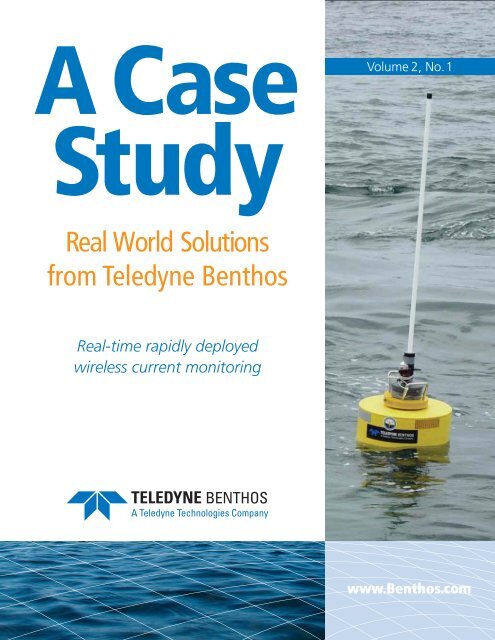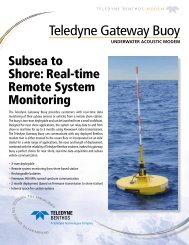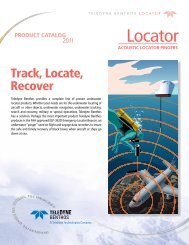Real-time rapidly deployed wireless current ... - Teledyne Benthos
Real-time rapidly deployed wireless current ... - Teledyne Benthos
Real-time rapidly deployed wireless current ... - Teledyne Benthos
Create successful ePaper yourself
Turn your PDF publications into a flip-book with our unique Google optimized e-Paper software.
A Case<br />
Study<br />
<strong>Real</strong> World Solutions<br />
from <strong>Teledyne</strong> <strong>Benthos</strong><br />
<strong>Real</strong>-<strong>time</strong> <strong>rapidly</strong> <strong>deployed</strong><br />
<strong>wireless</strong> <strong>current</strong> monitoring<br />
Volume 2, No. 1<br />
www.<strong>Benthos</strong>.com
<strong>Teledyne</strong><br />
<strong>Benthos</strong><br />
Equipment:<br />
Acoustic<br />
Modems<br />
Customer: Naval<br />
Oceanographic<br />
Offi ce<br />
Application: Underwater<br />
<strong>wireless</strong> data<br />
transfer<br />
Depth: 20 to 30 meters<br />
Range: Approximately<br />
1000 meters<br />
Data Rate: 1,200 bits/sec<br />
Host Sensor: <strong>Teledyne</strong> RD<br />
Instruments<br />
Workhorse<br />
Sentinel 600<br />
KHz or 300 KHz<br />
Acoustic Doppler<br />
Current Profi ler<br />
(ADCP)<br />
Modems: Gateway Buoy<br />
with ATM-885R<br />
OEM PCB, SR-50<br />
Acoustic release/<br />
modem<br />
NAVO wanted<br />
to reduce the<br />
size, weight,<br />
underwater<br />
footprint and<br />
complexity of<br />
deploying these<br />
systems.<br />
www.benthos.com<br />
The Challenge<br />
The Naval Oceanographic Offi ce (NAVO)<br />
needed to provide underwater <strong>current</strong><br />
profi les for Navy based test programs<br />
and exercises, such as AUV Fest. AUV Fest<br />
provides an environment for autonomous<br />
underwater vehicle (AUV) manufacturers<br />
to demonstrate their new vehicles and<br />
ancillary equipment to potential customers.<br />
Changing sea conditions can greatly<br />
infl uence the length and success of a<br />
mission, thus real-<strong>time</strong> data is extremely<br />
The Solution<br />
NAVO needed to collect <strong>current</strong> profi les<br />
from a <strong>Teledyne</strong> RD Instruments Acoustic<br />
Doppler Current Profi ler (ADCP) and<br />
transmit those profi les to shore in real<strong>time</strong>,<br />
so the acoustic modem solution was<br />
selected. They also required a reduced<br />
seafl oor footprint that was cost effective.<br />
The <strong>Teledyne</strong> <strong>Benthos</strong> SR-50 combined<br />
acoustic modem / acoustic release unit<br />
was selected. The SR-50 combines the<br />
proven, reliable modem and release<br />
technology offered by <strong>Teledyne</strong> <strong>Benthos</strong><br />
into a single unit, thus reducing the need<br />
for two subsea devices. The SR-50 was<br />
confi gured with a remote transducer<br />
head to allow optimum positioning of the<br />
transducer above the sensors for clear<br />
acoustic communication to the surface.<br />
The body of the SR-50 could then be<br />
located near the bottom of the mooring<br />
for best mechanical release functionality<br />
(see fi gure 1). The SR-50 and ADCP both<br />
contain internal batteries and interface<br />
through a single RS-232 cable. The sensor<br />
collected data once every half hour. The<br />
data was sent via RS-232 to the SR-50,<br />
which acoustically transmitted the data<br />
to the topside or surface modem.<br />
The topside modem was housed in<br />
a 2-person deployable, lightweight<br />
Gateway buoy. The buoy contained<br />
enough battery power for two weeks of<br />
transmission to shore using a FreeWave<br />
900MHz RF radio modem. The buoy<br />
also contained an ATM-885R OEM PCB<br />
acoustic modem which communicated<br />
acoustically to the SR-50 in the water and<br />
via RS-232 to the FreeWave radio modem<br />
important to the operators for their premission<br />
planning and real-<strong>time</strong> operations.<br />
<strong>Real</strong>-<strong>time</strong> systems typically require large<br />
buoys, large batteries, large bottom frames<br />
and expensive and cumbersome cables.<br />
NAVO needed to reduce the size, weight,<br />
underwater footprint and complexity of<br />
deploying these systems. <strong>Teledyne</strong> <strong>Benthos</strong><br />
was contacted for possible alternatives to<br />
their <strong>current</strong> mooring solution.<br />
which communicated through the air back<br />
to shore.<br />
The real-<strong>time</strong> data telemetry system can<br />
be <strong>deployed</strong> using smaller ships which<br />
cost less money to operate and are<br />
more readily available in most areas. The<br />
Figure 1 ADCP with SR-50 below and<br />
remote transducer head mounted in the<br />
upper right section of the frame
lightweight and compact design of the<br />
units allows NAVO to get the job done<br />
with less funding and in less <strong>time</strong>.<br />
After multiple deployments, NAVO<br />
requested a buoy modifi cation that<br />
would increase the deployment life and<br />
ruggedness of the buoy. Design ideas<br />
were discussed between NAVO, Mooring<br />
Systems Inc. and <strong>Teledyne</strong> <strong>Benthos</strong>.<br />
A new, more robust buoy system was<br />
designed with increased battery life to<br />
meet the longer deployment <strong>time</strong>s that<br />
Conclusion<br />
NAVO can now monitor the water<br />
conditions from shore, over a mile from<br />
the Gateway buoy, and receive real-<strong>time</strong><br />
<strong>wireless</strong> ADCP <strong>current</strong> information. The<br />
ADCP data is transmitted from subsea<br />
to the Gateway buoy through the water<br />
using the <strong>Teledyne</strong> <strong>Benthos</strong> combined<br />
were now required. The size was increased<br />
slightly and the buoy was designed more<br />
as a wave-follower (see fi gure 2). Using a<br />
new generation acoustic modem, the ATM-<br />
886-4G in a PVC housing allowed the buoy<br />
confi guration to change without increasing<br />
cost. Once all the customer requirements<br />
were satisfi ed, the buoys were shipped to<br />
NAVO, where they will be stored for use on<br />
upcoming projects.<br />
modem/ release SR-50. The Gateway buoy<br />
then relays that data <strong>wireless</strong>ly through the<br />
900MHZ Freewave radio to shore. The system<br />
works great and makes short term monitoring<br />
of the water conditions simple and effi cient<br />
for the end-users.<br />
Figure 2 New Gateway buoy. Designed in accordance with NAVO specifi cations.<br />
Acoustic modems<br />
provide users a reliable<br />
method to <strong>wireless</strong>ly<br />
retrieve data and<br />
perform command<br />
and control functions<br />
underwater. The<br />
systems provide a<br />
viable cost effective<br />
alternative to expensive<br />
cables and can be<br />
used for many subsea<br />
operations.<br />
<strong>Teledyne</strong> <strong>Benthos</strong>, Inc.<br />
49 Edgerton Drive<br />
North Falmouth, MA 02556-2826 USA<br />
T: +1 508.563.1000 F: +1 508.563.6444<br />
email: benthos@teledyne.com<br />
Copyright 2010, <strong>Teledyne</strong> <strong>Benthos</strong>, Inc.<br />
All rights reserved.<br />
www.benthos.com




